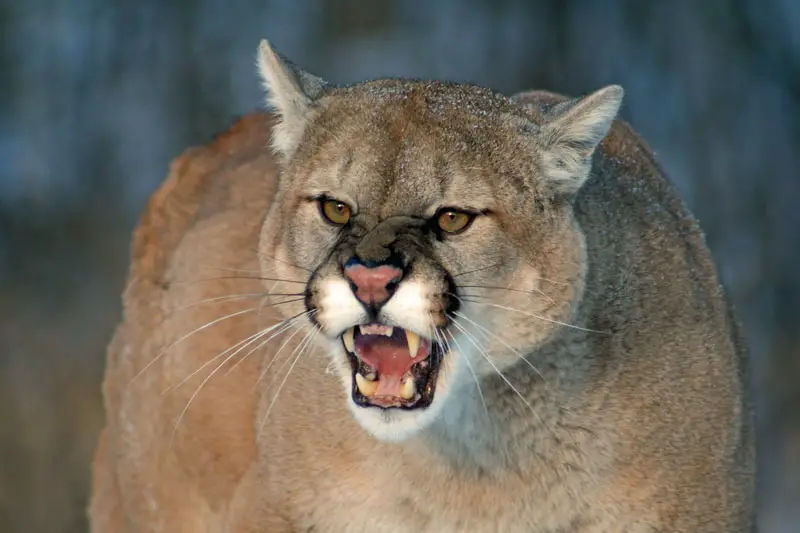There are 5 native wild cats in Arizona. They are the following.
- Mountain lions
- Bobcats
- Jaguars
- Ocelots
- Jaguarundis
Mountain lions and bobcats are quite common in the United States. On the other hand, jaguars, ocelots, and jaguarundis are more common in Mexico, Central America, and South America. Southern Arizona is in the extreme northern boundary of their range.
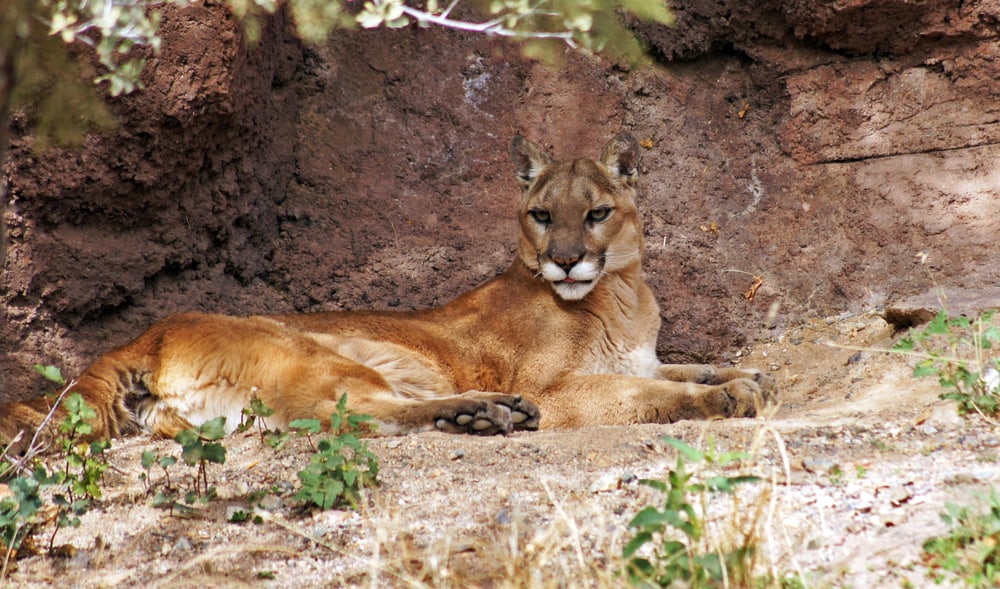
Mountain Lions in Arizona (Puma Concolor)
Mountain lions are the second most numerous Arizona wildcat species. According to Arizona Game and Fish Department statistics, the average cougar population within the state from year to year is 2,876 animals.
Physical Characteristics of Mountain Lions
Mountain lions are similar in phenotype to a domestic cat except they’re a lot larger. These animals, in general, have lean, sinewy bodies, somewhat round heads, and upright ears that are rounded at the tip. Another one of the mountain lion’s distinguishing characteristics is its long tail, which accounts for almost one-third of its entire length.
What’s more, they have a light brown coat of short, coarse hair over most of their body. They have black on the tip of their tail, their ears, and the area around their nose. Their belly, the area above their upper lip, below their lower lip, and their chin are all white. They also have a sprinkling of dark hair on their backs. Also, bear in mind that their coat color varies somewhat with geographic location.
Male and female mountain lions seem identical, but males are 30 to 40% bigger than females. Though sizes vary considerably throughout the cat’s geographic range, an adult male typically weighs between 110 and 180 pounds, 50 to (82 kgs). A rare few of them grow bigger than 200 pounds (91kgs). Female mountain lions or queens average between 80 and 130 pounds (36 to 59 kgs). Adult males or toms will reach a length of 6 to 8 feet (1.8 to 2.4 M) from their snout to the tip of their tail. On the other hand, adult females are 5 to 7 feet long (1.5 to 2.1 M).
Mountain lions are the fourth largest wildcat in the world. They are smaller in size only to the Jaguar in the Americas. However, worldwide, the African Lion and the Tiger are also larger. Ironically, despite their large size, they are not taxonomically classified as big cats because they cannot roar. Leopards, for example, are smaller than mountain lions, but since they can roar, they are classified as big cats, while mountain lions are not.
A mountain lion is a formidably tough wild animal. They can run 40 to 50 miles per hour for short bursts and jump up to 40 feet with a running start. They can also leap 15 feet vertically from a flat-footed start. See
Where Are Mountain Lions Typically Found?
According to the Arizona Game and Fish Department, mountain lions are scattered throughout the state. Their natural habitats include both desert and mountain terrain. They prefer steep rocky areas to sleep in during daylight hours. They also like areas with thick cover when they are hunting to stalk and ambush prey.
These elusive cats cover a lot of terrain. An adult male’s home range is normally more than 100 square miles.
They will be in places as diverse as the Mogollon Rim or the Sonoran Desert as long as their prey is there.
What do Mountain Lions Eat?
Mountain lions are opportunistic predators that hunt mostly nocturnally, stalking their prey, mainly deer (In Arizona, this would be mule deer or Coues deer) from behind. On average, a lion kills a deer or an equivalent source of protein once a week. Arizona mountain lions potentially prey on the following animals.
- Deer
- Elk
- Desert bighorn sheep
- Pronghorns
- Feral horses
- Javelinas
- Wild pigs
- Coyotes
- Skunks
- Raccoons
- Birds
- Reptiles
- Small pets
- Domestic livestock and literally anything else they can catch
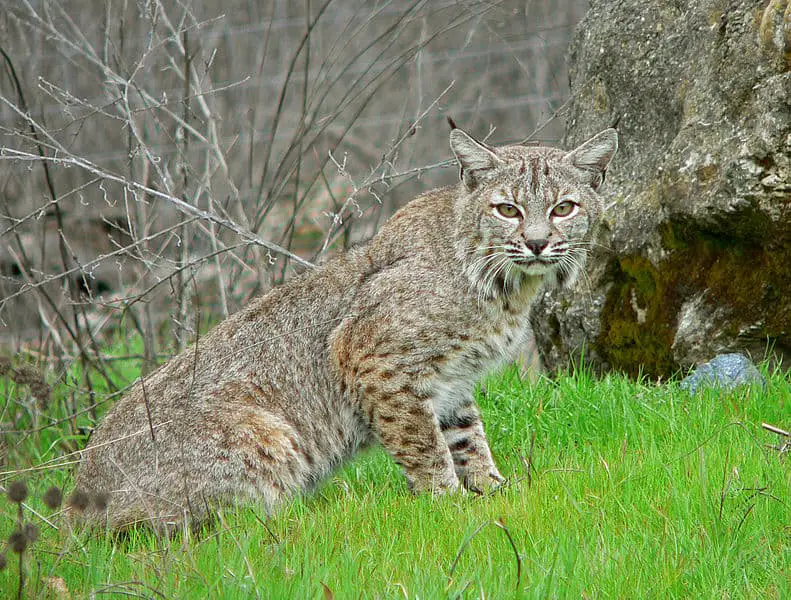
Arizona Bobcats (Lynx rufus)
Bobcats live only in North America. Their range begins in southern Canada, about where the range of the Canadian lynx begins to dwindle out and extends south into southern Mexico.
Physical Characteristics of Bobcats
A bobcat is much smaller than a mountain lion. In fact, bobcats that are a little on the small side are not much bigger than large domestic cats.
A bobcat is 2 to 4 feet long and weighs about 15 to 35 pounds. Female bobcats are quite a bit smaller than males.
These animals have a short tail with a black tip rather than a long one. Their fur is usually gray to brown, with dark mottled spots that range from brown to black on their bodies. They also have dark bars on their inner forelegs and tail.
From a side view, you will notice that a bobcat is slightly higher in the rump than at the shoulders. Bobcats and lynx have long hind legs in proportion to their forelegs.
Their ears have tufted points that are black at the tips. Their whiskered face seems broader due to their long, ruffled facial hair and whiskers. Their eyes are yellow most of the time, with vertical slit-shaped pupils.
Bobcats are fierce animals. If you get one cornered, it will hiss, growl, and spit like one of the nastiest house cats you’ve ever run into x a million. They mean it, too. They have to be tough and mean to survive.
What Do Bobcats Eat?
Despite their comparatively small size, bobcats are aggressive, tough predators. In exceptional circumstances, they have the ability to prey on larger animals, such as small deer. However, their regular diets mainly consist of small mammals, reptiles, birds, and carrion. A bobcat’s potential menu in Arizona consists of the following listed by degree of importance.
- Small mammals such as rabbits, rats, and mice
- Reptiles
- Birds
- Carrion
- Larger mammals such as javelina young deer and young pronghorns
- Occasional small livestock or household pets
Bobcats even prey on venomous snakes such as coral and rattlesnakes, even though they are not immune to snake venom. They accomplish this by using their quickness to pin the snake’s head down with a paw, after which they dispatch the snake with a quick bite behind the head.
Where Do Bobcats Live in Arizona?
Arizona has between 62,395 and 65,909 bobcats. This is according to a study conducted jointly by Cornell University and the University of Montana in 2010. You can round the numbers down to 62,000 and up to 66,000 respectively.
As with mountain lions, Arizona bobcats are liberally distributed throughout the state. They are at home in the mountains or in the desert. They are wherever their prey is located.
Although both mountain lions and bobcats are capable of living in areas that are close to human population centers, bobcats seem to be less affected by human encroachment than mountain lions are. It’s not unheard of for them to make nocturnal visits to people’s homes in such urban areas as Phoenix for example. There are also bobcats in the Tucson area.
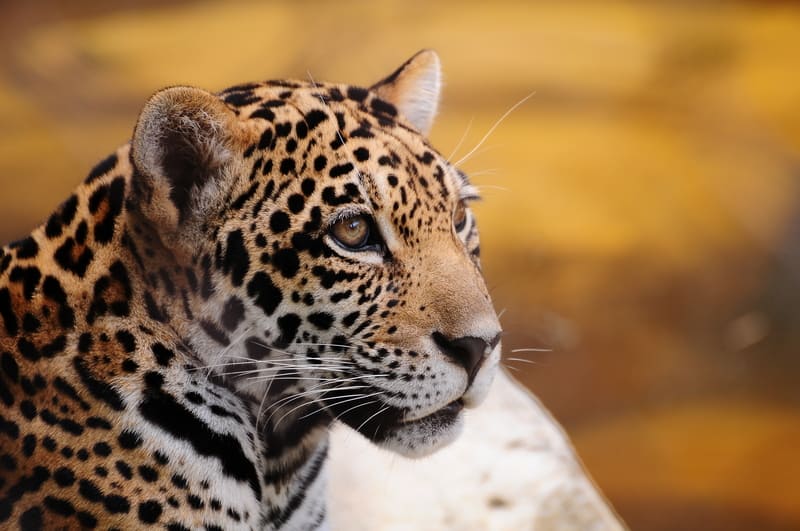
Jaguars In Arizona (Panthera onca)
Jaguars are the largest cat in the Americas and the third largest wild cat in the world. Only the tiger and the African lion are larger than the jaguar. They are stout, muscular cats with legs that are short in proportion to their body size. Their legs are also short in comparison to other similarly sized big cats.
According to Wikipedia, they range from 68 to 75 cm ((26.8 to 29.5 in) in shoulder height. Their body length from the tip of the nose to the rump varies from 1.12 to 1.85 m (3 ft 8 in. to 6 ft 1 in). Additionally, their weight ranges from 56–96 kg (123–212 lb.). Males are usually 10 to 20% larger than females.
In appearance, a jaguar resembles a leopard with thicker, stouter features. The color of their hair coat along their back and sides ranges from light tan to light orange, overlaid with black spots. There are also extremely rare melanistic jaguars that are completely black. People sometimes mistakenly call these black panthers.
What do Jaguars Eat?
Jaguars are apex predators and, thus, opportunistic feeders that feed on a variety of prey. Monkeys, capybara, tapir, and caimans are just a small sample of the animals on their menu in South and Central America. They even use their tails to lure in fish to catch. In Mexico, their diet overlaps with that of the mountain lion in that a large percentage of their diet consists of deer meat.
In southern Arizona, a jaguar’s diet is going to be similar to that of one in Sonora. They will prey on the following.
- Deer
- Pronghorns
- Javelina
- Smaller prey, such as reptiles, birds, rabbits, and packrats.
Where Do Jaguars Live?
The range of the jaguar extends into all three American continents, from Argentine Patagonia in the south to the U.S/Mexico border country in the north.
Before European settlement in what is now the United States, the Jaguar’s former range stretched across southern Texas, New Mexico, and Arizona and as far north as the South Platte River in Colorado.
Since 1996 seven jaguars have been sighted in the United States. These were all either in southern Arizona or southwestern New Mexico. All 7 of the jaguars sighted were males. This leads biologists to believe that these males are looking to expand into new territory north of the main breeding population, which resides in Sonora, Mexico.
One of the more famous jaguar sightings in Arizona was of a cat nick named El jefe. For a time, this big cat was the only wild jaguar known to be living in the U.S. El jefe was spotted in various spots around southern Arizona in person and on wildlife cameras from 2011 through 2015. After that, he disappeared from view. El jefe was recently spotted in Sonora, Mexico, around 120 miles south of where he was last spotted in Arizona. Source
The U.S. Fish and Wildlife Service listed jaguars outside the United States on the endangered species list in 1972.
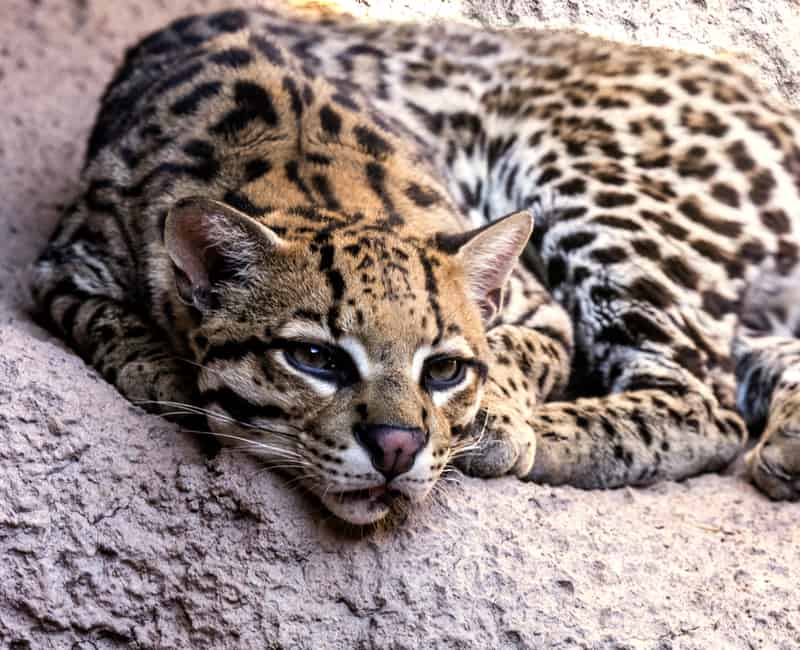
Arizona Ocelot (Leopardus pardalis)
Ocelots are medium-sized wild cats. Adult ocelots range in weight from 24 to 35 pounds (10.88 to 15.87 kg). What’s more, they range in height from 28 to 35 inches (71.12 to 88.9 cm). Their body length varies between 28 and 35 inches (71.12 to 88.9 cm), and their tails are up to 18 inches (45.72 cm) long.
An ocelot’s coat is creamy yellow to grey, overlayed with extensive black markings. Several black lines run from the back of their necks to the tips of their tails. The neck and underside of an ocelot is white. Additionally, they have a white spot on a black background on the back of each ear. Each ocelot has a unique color pattern that can be used to distinguish it from other ocelots.
It’s popular in some circles to keep ocelots as pets. However, they come with a set of problems that domestic cats don’t have. They are wildcats with an ingrained instinct to hunt and kill, so your neighbor’s pets will be at risk. They’re also very destructive to carpets and furniture. Another problem with domesticating an ocelot is that their feces and urine carry a very rank odor not found with domestic cats. Additionally, ocelots have an inborn instinct to scent mark their territory.
What Do Ocelots Eat?
In Central and South America, their diet also includes such animals as small monkeys and iguanas. In Arizona an ocelot’s menu would consist of the following.
- Small mammals
- Birds
- Reptiles
- Amphibians
- Insects
- Small desert fish and crustaceans
In Central and South America, such animals as small monkeys armadillos and iguanas also fall prey to ocelots.
Where Do Ocelots Live?
Ocelots range from parts of Argentina north through South America, central America, and Mexico to the southwestern United States. In the U.S., Ocelots live in Texas and southern Arizona. Like with jaguars, the ocelots spotted in Arizona in recent years have all been males. Biologists believe that these animals originated from the closest known breeding population, which is further south in Sonora, Mexico.
Only around 100 wild ocelots remain in the United States. Most of these are in Texas. Consequently, they are on the Federal Government’s endangered species list.
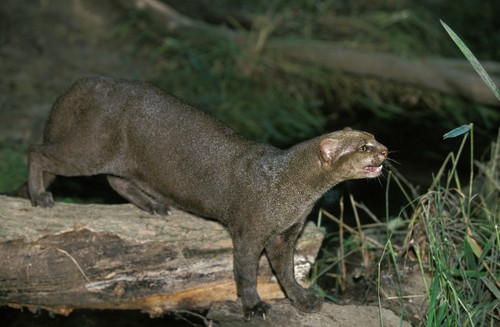
Arizona’s Jaguarundi (Herpailurus yagouaroundi or Puma yagouaroundi )
Another name for the Jaguarundi is eyra cat. Jaguarundis are small wild cats that are native to the three American continents. They are roughly twice the size of a large domestic cat. That is what they resemble, with some minor distinctions. They have an elongated body with proportionately short legs. Additionally, they have a narrow head with small, wide-set ears. This gives them the slight appearance of a mustelid rather than a cat.
Adult jaguarundi stands around 14 inches (35.56 cm) at the shoulder and weighs 6.6 to 15 pounds (3 to 6.80 kg) These small feline predators use at least 13 different vocalizations that includes whistles, birdlike chirping and purring.
Jaguarundis have two color morphs. They are either grey or brown.
What Do Jaguarundis Eat?
Jaguarundis prey on small mammals, reptiles, and birds.
Where Do Jaguarundis Live?
Jaguarundis live from Argentina north through South and Central America and Mexico up to the desert southwest of the United States, in Texas, New Mexico, and Arizona.
Accounts of early settlers indicate that jaguarundis were commonly seen in parts of Arizona in the 1800s. They ranged as far north as the Mogollon Rim country. However, the degradation of their habitat due to human encroachment and predator control eliminated them from much of their former Arizona habitat.
Jaguarundis likely live in Arizona because people are seeing them there. However, although there are several reported jaguarundi sightings in Arizona each year, none of these have ever been officially confirmed. If they are within Arizona, they are most likely to be within the “Sky Island “ranges. This is in the southeastern portion of the state.
In Conclusion
Make it a point to go on an unforgettable adventure in Arizona’s wild country. Go where you can experience the natural habitats of mountain lions, bobcats, and elusive jaguars, jaguarundis and ocelots. Whether you’re hiking the desert or exploring the mountains, Arizona’s wildlife awaits. Just remember to keep your eyes peeled for these awesome creatures. While you’re out there, consider the importance of preserving their habitats to ensure future generations can enjoy these wild cat species too.
Also, See
Wild Cats of Texas – Krebs Creek
Wild Cats In New Mexico – Krebs Creek
Recent Posts
The only venomous snakes in Washington State are Northern Pacific Rattlesnakes. The Northern Pacific Rattlesnake (Crotalus oreganus oreganus) is a sub-species of the Western Rattlesnake. Anyone...
Skunks are not classified as true hibernators. But they go into a state of torpor when the weather gets cold. Skunks are light sleep hibernators, along with opossums, bears, and raccoons. ...

